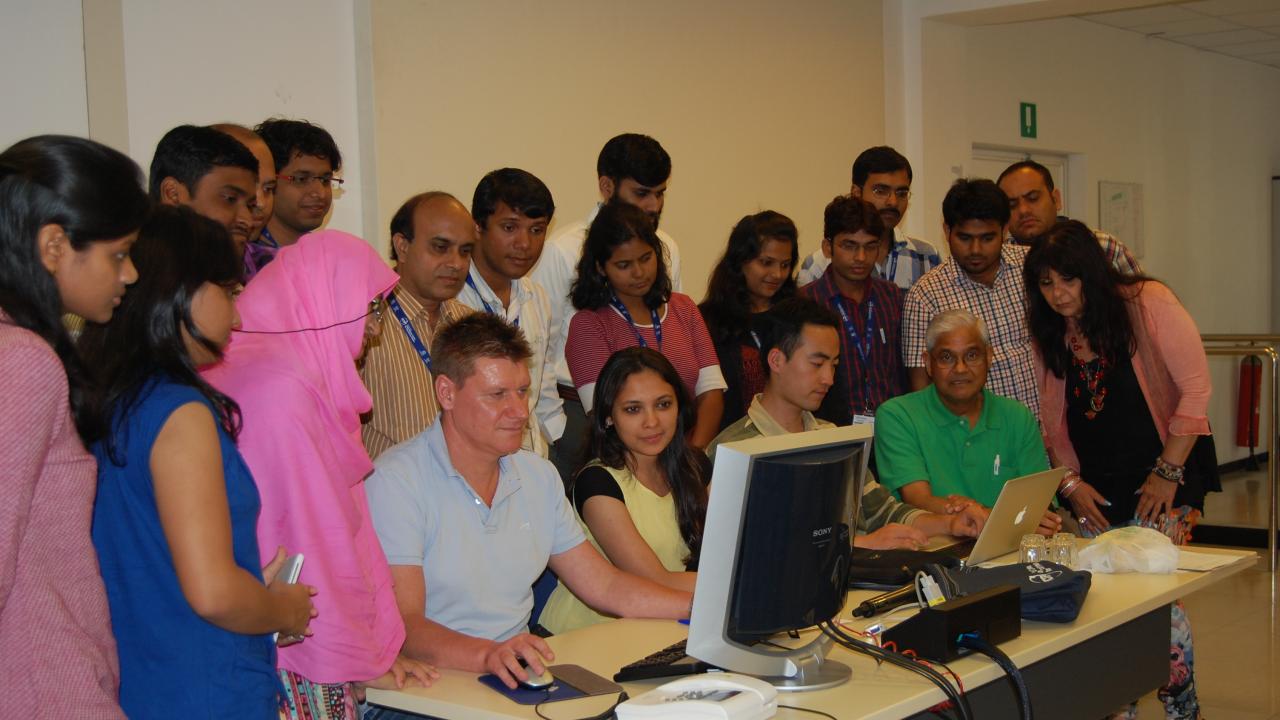
A year's worth of work and livelihood, parched and wilting under an Indian farmer's feet; flash flooding in Pakistan, submerging a fifth of the country; freak rainstorms in the Saudi Arabian desert claiming the lives of 122 people. These are some of the weather events that have motivated scientists from around the world to attend the Targeted Training Activity (TTA) on Monsoon Prediction at ICTP.
Since 2004, the TTA, now in its sixth meeting, has trained scientists in affected countries in the latest computer modeling techniques for seasonal prediction of monsoons. It is jointly coordinated and funded by the Indian Institute of Tropical Meteorology (IITM) and George Mason University's Center for Ocean, Land, Atmospheric Studies (COLA), and organised at ICTP by Fred Kucharski and Lisa Iannitti, the TTA's secretary from the beginning of the program.
Although seasonal prediction is relatively new, there is ample evidence that some elements of the climate system can be accurately forecasted. Professor Jagadish Shukla of COLA, the TTA founder, characterised scientists in this field as "explorers" looking for "predictable components in the midst of chaos." The work of these explorers can make a huge difference to the 3 billion people affected by the monsoon each year.
Shukla, who has been coming to ICTP for 25 years, came up with the idea of the TTA because of his frustration that ICTP's lessons were carried home by individual scientists, rather than whole institutions. "There's no memory left," he said. "Another group comes, and there's no impact." So he proposed an alternative model: target scientific groups, both research and operational scientists, and invite everyone from a particular center. The goal is to engage both forecasters and lecturers who can teach the skills they learn in their home countries.
By training a group of scientists from the same institution, and inviting the same scientists back year after year, Shukla hoped to achieve "critical mass and repeatability." It seems to have worked: some participants who first attended as students are now professors in their home countries and return to each TTA to remain at the cutting edge.
Each time it meets, the TTA is a two-to-three week seminar, with morning lectures and afternoon computer lab sessions. On the afternoon of the third day of this year's activity, the participants huddled around computers in the basement lab of the Adriatico Guesthouse. In groups of four, they discussed the colorful maps that showed their model results and solicited advice from the instructors who circulated in the room, helping to find bugs in the code. The lab component officially ends at 5 pm each day, but co-director Fred Kucharski of ICTP says that the students often work on their models late into the night.
Although some of the computer lab groups are focusing their modeling on a particular region, such as rain on the Arabian peninsula or floods in Pakistan, others are interested in a particular theme. A group from Africa modeling malaria, for example, is working together with a company from India, BKC WeatherSys, that provides monsoon forecasts to farmers.
Jaya Kumar of BKC WeatherSys told her fellow participants that at the TTA she's been able to have "conversations to bring forecasts to farmers," a critical need when 70% of India's large population is dependent on agriculture for its livelihood. She hopes that the collaborations formed at this year's TTA will lead to successes she can share at a future meeting.
Already, the TTA has several success stories - so many, it dedicated a morning session at the end of the first week to sharing them. Many are personal, such as the motivation and inspiration of the Indian PhD students who come each year, related by Dr. Bhupendra N. Goswami, an activity director from the IITM, or the job offers received by students of Professor In Sik Kang of Seoul National University, a lecturer in the program. But the TTA has also had larger scientific and political impacts.
In 2009, the Directors General of the national meteorological institutes of eight South Asian countries affected by the monsoon convened the South Asian Seasonal Climate Outlook Forum at ICTP for the first time. The World Meteorological Organization had already set up a regional outlook forecast forum for Africa, but the involvement of TTA organisers and participants was crucial to setting up the first such organisation in Southeast Asia. Now, they meet each year to discuss their monsoon predictions.
Another TTA success has been its increasing geographic impact. Last year, in partnership with IITM, the meeting was held in Pune, India. The organisers plan to alternate between India and ICTP in future years, since traditionally many participating institutions have been from the Indian subcontinent. Recently, however, the geographical scope of the TTA has spread to encompass other areas of the world affected by monsoon-like weather: Africa, South America, East Asia, and Arab countries.
Shukla would like to see still more benefits from the TTA. In particular, he thinks its successes prove its worth as a useful model that could be adopted by other research groups at ICTP. "This should be followed from other disciplines," he said. "It's a way to make a significant impact."
















